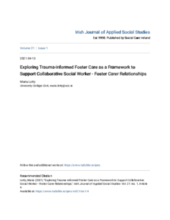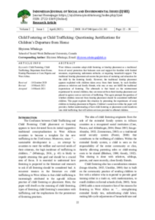Displaying 161 - 170 of 2214
This article offers an account of the authors’ experiences as foster carers for an unaccompanied asylum seeker (and through him, supporting other asylum-seeking boys).
In the present study, the authors explored the adult-child interactions that took place in 116 families from Spain: 28 long-term non-kin foster families, 34 adoptive families, and a community comparison group made up of 54 families.
This study aimed to better understand the role that Court-Appointed Special Advocates (CASAs) play in the lives of transition-age youth (TAY) by asking participants about the nature of their relationships with their CASAs, and the extent to which their CASAs helped prepare them for independent living.
This paper suggests a new framework, Trauma-informed Foster Care that was developed to reflect the experience of the Irish foster care system, may be helpful to support more collaborative practices between foster carers and social workers in an Irish context.
This article explores the concept of care and the responsibility assumed by ‘states’ when taking children into care.
The current study used survival analysis to investigate whether the type of placement (kin versus non-kin) related to the number of placement disruptions over time.
The purpose of this study was to provide a population-based analysis of child protection system (CPS) involvement among children and adolescents who died by suicide.
This paper explores whether children removed from kinship placement should be considered trafficked children by presenting the experiences of some children in kinship placement in Nigeria.
The current study used population-based administrative records from California to assess how CPS responds to reported allegations of IPV, with and without physical abuse and/or neglect allegations.
This study experimentally tested proximal outcomes of Connecting, a low-cost, self-directed, family-based substance-use prevention program for foster families.



